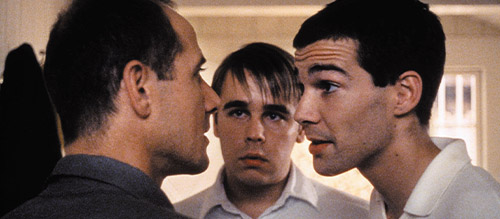Funny Games and the Victimisation of the Audience
Do films exist without their audiences? If no-one is there to witness the images projected onto the screen, is it worth committing them to celluloid? Is a horror film truly successful if not a single scream is heard in the theatre?
The relationship between films and spectators is the invisible foundation upon which all cinema is built – or at least it was. Dominating studio trends of fan service and fourth-wall breaks are ensuring that this connection is growing more opaque and susceptible to manipulation. Few genres are, however, as dependent upon audience provocation than horror; a genre that feeds on implanting nightmares and twisted thoughts within their viewers’ minds. On the surface, Michael Haneke’s Funny Games belongs to the familiar home invasion sub-genre of spooks – an innocent married couple and their young son have their holiday rudely interrupted by a pair of sadistic upper-class men who trap and force them to play the aforementioned ‘funny games’. It doesn’t take a genius to figure out their plans aren’t as straightforward as a round of Uno and some spin-the-bottle. Nonetheless, it’s not the cruelty that defines Funny Games’ frights, although it certainly comes close in a few instances. Haneke creates fear through aiming the camera directly at his audience, asking the bone-chilling question: why does this film exist?
Reputable for cold and clinical films, Funny Games is hardly an outlier in Haneke’s filmography. Through opting for harsh realism over extraordinary qualities, the film immediately offers up its own cinematic presuppositions for sacrifice at the audience’s behest. Whilst a contemporary film like The Strangers: Prey at Night is comfortably inauthentic with its loud neon colours and heavy stylisation, Funny Games disturbingly refuses to concede its anything but grim reality. This is transparent through minimalist editing that carefully plants cuts as rewards for enduring lengthy static shots of violence. As with another Haneke thriller, Cache, and its notorious opening shot, the deliberate lack of momentum creates unique sensations of discomfort and paranoia, unlike anything many would have experienced elsewhere in horror cinema.
The unrelenting cruelty is often suffocating and is overwhelming by nature, heightening the moments absent of any threat. There’s a sequence on the cusp of the second and third acts in which protagonists Anna and Georg mercifully appear safe; for a solid 20 minutes, there’s little to spectate other than the slow recovery of these characters from their shared trauma. This extreme slowdown serves as a sneaky Rorschach test for the viewer – do you empathise with their pain or are you bored waiting for the next extreme set piece? Once blood begins to be shed, horror films typically rely on constant thrills and frights until the credits to satiate audiences’ unconscious desires to see these fictional heroes suffer. It’s the fundamental principle behind the successes of gargantuan franchises including Friday the 13th or A Nightmare on Elm Street. Without the inherent thrills nestled amongst brutal kills and close shaves, there’s little ground for the slasher or home invasion film to stand upon. Through swiftly deconstructing the scaffolding that has kept these films secure for so long, Funny Games explodes both itself and an entire genre in spectacular style.
All of this reverse engineering wouldn’t succeed if it weren’t for the affecting performances and brilliantly punctuated writing. Susanne Lothar and Ulrich Mühe are excellent at drawing sympathy and riding the motions of the turbulent narrative, but it’s Arno Frisch and Frank Giering as the malevolent Paul and Peter who truly shine. Frisch’s straight-to-camera delivery isn’t a revolutionary concept today, but his obnoxious edge creates audience addresses that feel distinctly nasty instead of the more familiar cheeky aside. If anything, Frisch becomes a surrogate for Haneke, frequently punishing the audience and reminding them of their complicity in merely choosing to continue watching their horrible crimes unfold. One fourth-wall break in the final act is gleefully transgressive, clearly establishing that Funny Games is a horror film without rules or logic. His performance serves to remind the audience that they are not in control; they are as vulnerable as any horror victim.
As Haneke has repeatedly stated, Funny Games isn’t so much a clear-cut horror film as it is a nihilist exercise attempting to expose audience attitudes to on-screen violence. Whilst all this is evidently true, there is similarly no doubt that Funny Games is an exemplary horror film and one of the best of its kind. This film roots out fear from both its frightening invasion scenario and from the state of cinema itself; a world in which art is invaded by needless violent images designed for nothing but viewer pleasure. Funny Games’ most provocative shot hangs on a blood-covered television broadcasting a racing tournament, leaving a gory veil over a familiar spectacle. Why does Funny Games exist? Why are its images committed to celluloid? The answer is simple: audiences love the gory veil.
Written by Jacob Heayes
You support Jacob Heayes in the following places:
Twitter – @heyimjay_cob
Medium – @jacobheayes



